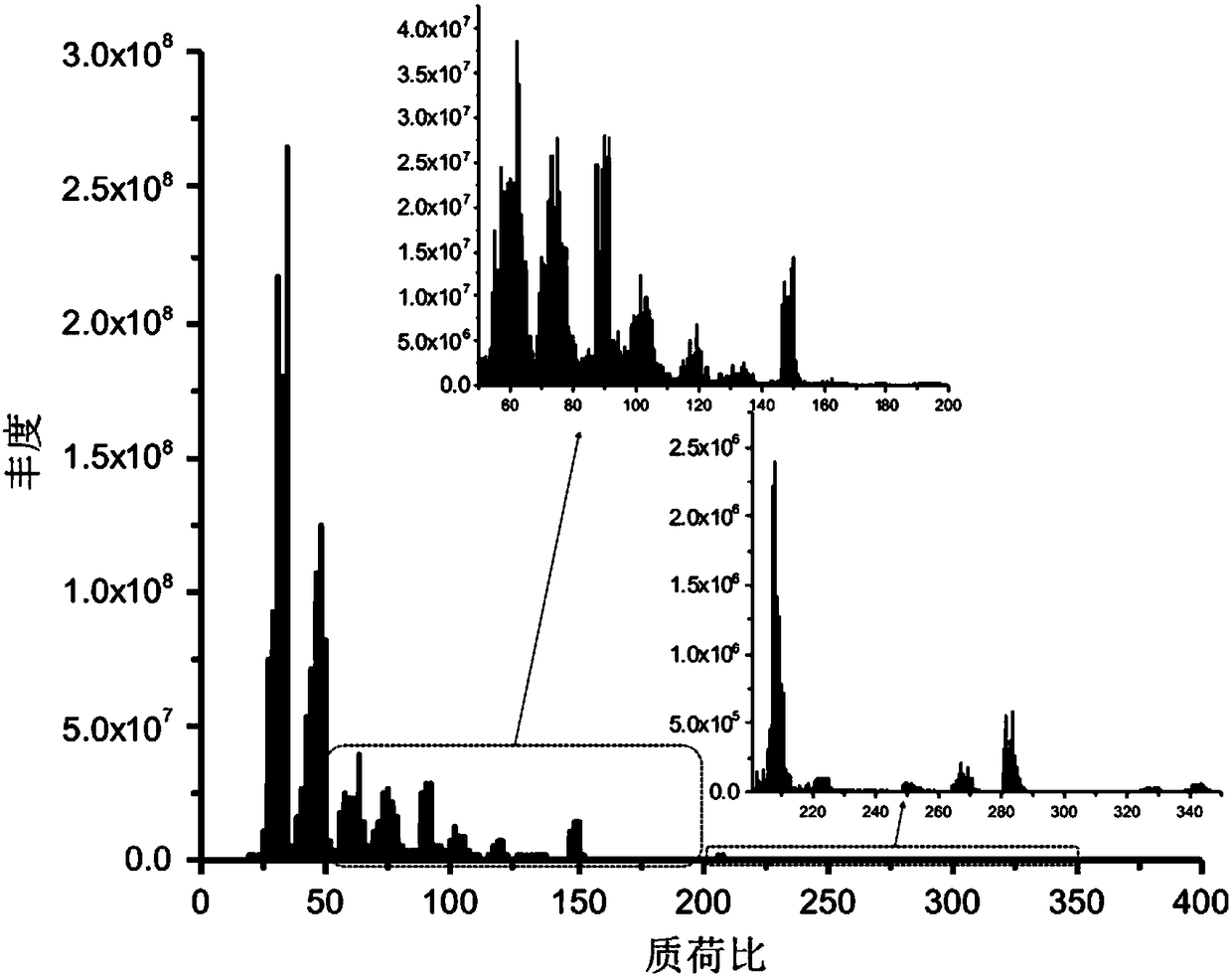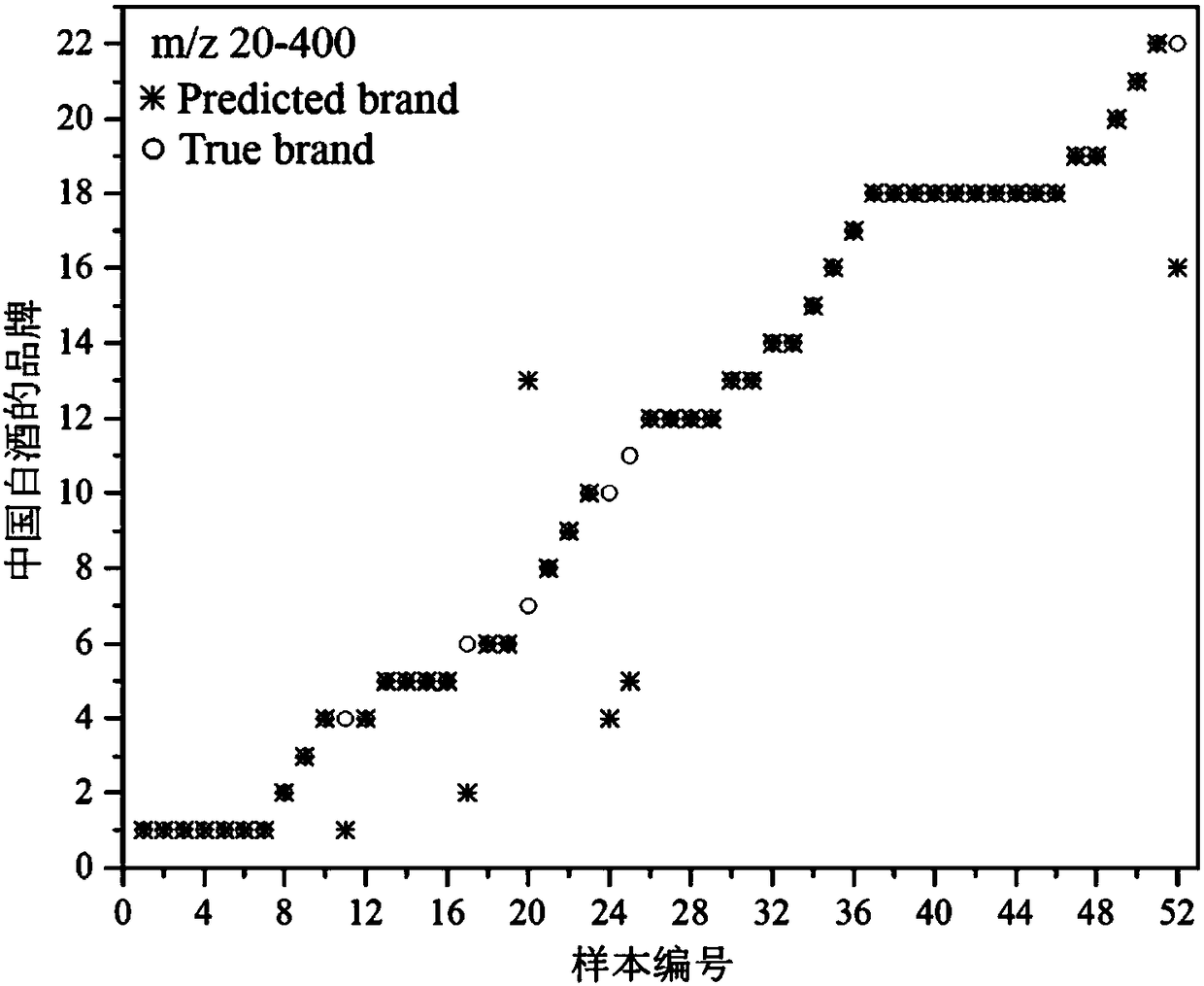Method for identifying wine products
A product and wine technology, which is applied in the field of wine product identification, can solve the problems of limited identification ability, effort, and high cost of use, and achieve the effects of high detection sensitivity, objective and reliable results, and simple operation
- Summary
- Abstract
- Description
- Claims
- Application Information
AI Technical Summary
Problems solved by technology
Method used
Image
Examples
Embodiment example 1
[0064] Implementation case 1: brand identification of Luzhou-flavor liquor1.
[0065] 1. Sample preparation:
[0066] a. Sampling: 253 wine samples, 34 brands, and 6 flavor types were collected. For specific liquor information, see Table 1. Take 1 mL of liquor sample.
[0067] b. Sample preparation: Add deionized water to dilute to 31% vol, then add sodium chloride at a molar ratio of 1mol / L, stir to dissolve completely, take 10mL of the treated sample into a 20mL threaded headspace bottle; Empty solid-phase microextraction (HS-SPME) conditions: samples were first incubated at 42.5°C for 32.5 min, and then extracted at the same temperature for 37.5 min using a solid-phase microextraction fiber (75-μm CAR / PDMS) with a stirring speed of 100 rpm.
[0068] c. Storage: If the samples obtained in the above sample preparation steps are not tested immediately, they should be stored at -20°C for later use.
[0069] Table 1 Liquor sample information
[0070]
[0071]
[0072]...
Embodiment example 2
[0083] Implementation case 2: Brand identification of Luzhou-flavor liquor 2.
[0084] 1. Sample preparation:
[0085] A, sampling: same as embodiment 1;
[0086] B, sample preparation: same as embodiment 1;
[0087] c. Storage: The storage temperature is 4°C.
[0088] 2. Data collection:
[0089] d. Sample injection: take 2 μl of the prepared sample above for instrumental analysis;
[0090] e. Sample running: The instrument used is a fully automatic two-dimensional gas chromatography-time-of-flight mass spectrometer (LECO, USA); gas chromatography heating program: the initial temperature is 60 ° C, kept for 1 minute, and then heated to 1 ° C / min speed 165°C, then raised to 280°C at a rate of 20°C / min, and kept for 14 minutes. Detector temperature: 280°C.
[0091] Mass spectrometry conditions: scan range is 20 to 400u, acquisition rate is 100spectra / s, voltage is 70eV, ion source temperature is 220°C, transmission line temperature is 250°C, detector voltage is 1700V, t...
Embodiment example 3
[0097] Implementation case 3: brand identification of Luzhou-flavor liquor3.
[0098] 1. Sample preparation:
[0099] A, sampling: same as embodiment 1;
[0100] B, sample preparation: same as embodiment 1;
[0101] c. Storage: The storage temperature is 0°C.
[0102] 2. Data collection:
[0103] d. Sample injection: take 2 μl of the prepared sample above for instrumental analysis;
[0104] e. Sample running: the instrument used is a fully automatic two-dimensional gas chromatography-time-of-flight mass spectrometer (LECO, USA); gas chromatography heating program: the initial temperature is 60 ° C, kept for 1 minute, and then heated to 10 ° C / min speed 165°C, then raised to 280°C at a rate of 30°C / min, and kept for 14 minutes. Detector temperature: 280°C.
[0105] Mass spectrometry conditions: scan range is 20 to 400u, acquisition rate is 100spectra / s, voltage is 70eV, ion source temperature is 220°C, transmission line temperature is 250°C, detector voltage is 1700V, t...
PUM
| Property | Measurement | Unit |
|---|---|---|
| volume | aaaaa | aaaaa |
| volume | aaaaa | aaaaa |
Abstract
Description
Claims
Application Information
 Login to View More
Login to View More - R&D
- Intellectual Property
- Life Sciences
- Materials
- Tech Scout
- Unparalleled Data Quality
- Higher Quality Content
- 60% Fewer Hallucinations
Browse by: Latest US Patents, China's latest patents, Technical Efficacy Thesaurus, Application Domain, Technology Topic, Popular Technical Reports.
© 2025 PatSnap. All rights reserved.Legal|Privacy policy|Modern Slavery Act Transparency Statement|Sitemap|About US| Contact US: help@patsnap.com



